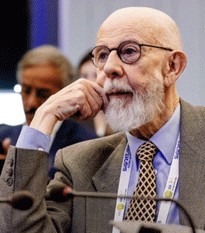

#INTHEAIREVERYWHERE
| |
 |
 #INTHEAIREVERYWHERE |
|
| Vol. 23 No. 52 | Friday
December 20,
2024 |
|
| |
Flying By The Trillions In 2025 |
Quoting a commercial to start this article is more than unexpected for me, but this one suits the purpose in so many ways that it is probably worth making an exception. In about one minute, you realize the incredible importance and dimension of air travel: you just want to multiply the figures you hear from Singapore Airlines in their BBC ad by the unimaginable number of connections worldwide to understand the magnitude and impact of modern aviation. In a way this is what IATA’s ‘Global Outlook for Air Transport’ is proposing, almost as a year-end present for its public. IATA’s Press Release 58 says it all in its title: “Strengthened Profitability Expected in 2025 Even as Supply Chain Issues Persist.” IATA did not miss this opportunity to re-focus on the importance of its members’ global reach: “IATA highlighted the broad benefits of growing connectivity. The most recent estimates show that airline employment is expected to grow to 3.3 million in 2025. Airlines are the core of a global aviation value chain that employs 86.5 million people and generates $4.1 trillion in economic impact, accounting for 3.9% of global GDP (2023 figures). Connectivity is an economic catalyst for growth in nearly all industries. Looking at 2025, for the first time, traveler numbers will exceed five billion and the number of flights will reach 40 million. This growth means that aviation connectivity will be creating and supporting jobs across the global economy. The most obvious are the hospitality and retail sectors which will gear up to meet the needs of a growing number of customers. But almost every business benefits from the connectivity that air transport provides, making it easier to meet customers, receive supplies, or transport products. On top of this, growth in aviation also contributes to achieving almost all the UN’s Sustainable Development Goals (SDGs).” None of the boxes is left unticked; perhaps those who still hope in a more considerate approach toward the environment may raise an eyebrow, considering they have always looked at air travel as a principal pollutant, but . . . It is difficult to believe their voice will sound very loud in 2025, at least until we hit another cataclysm. On the other hand, it should be noted that few industries have done as much as aviation to improve their environmental performance and the overall impact of aviation is extremely small if compared to bigger sources of emissions, for example livestock or road transport.
Anyhow the barometer is set to fine weather. This is how IATA itself gives the good news, providing all necessary detail: “Net profits are expected to be $36.6 billion in 2025 for a 3.6% net profit margin. That is a slight improvement from the expected $31.5 billion net profit in 2024 (3.3% net profit margin). Average net profit per passenger is expected to be $7.0 (below the $7.9 high in 2023 but an improvement from $6.4 in 2024). Operating profit in 2025 is expected to be $67.5 billion for a net operating margin of 6.7% (improved from 6.4% expected in 2024). The return on invested capital (ROIC) for the global industry is expected to be 6.8% in 2025. While this is an improvement from the 2024 ROIC of 6.6%, the returns for the industry at the global level remain below the weighted average cost of capital. ROIC is the strongest for airlines in Europe, the Middle East, and Latin America, where it did exceed the cost of capital. Total industry revenues are expected to be $1.007 trillion. That is an increase of 4.4% from 2024 and will be the first time that industry revenues top the $1 trillion mark. Expenses are expected to grow by 4.0% to $940 billion. Passenger numbers are expected to reach 5.2 billion in 2025, a 6.7% rise compared to 2024 and the first time that the number of passengers has exceeded the five billion mark. Cargo volumes are expected to reach 72.5 million tonnes, a 5.8% increase from 2024.” IATA remains adamant these optimal figures will translate into a wealthier than usual bottom-line. “We’re expecting airlines to deliver a global profit of $36.6 billion in 2025. This will be hard-earned as airlines take advantage of lower oil prices while keeping load factors above 83%, tightly controlling costs, investing in decarbonization, and managing the return to more normal growth levels following the extraordinary pandemic recovery. All these efforts will help to mitigate several drags on profitability which are outside of airlines’ control, namely persistent supply chain challenges, infrastructure deficiencies, onerous regulation, and a rising tax burden.” These were Willie Walsh’s words in his role as IATA’s Director General. After a number of years spent contemplating the lower end of his deck of cards, Walsh was eventually able to play his ace: “In 2025, industry revenues will exceed $1 trillion for the first time. It’s also important to put that into perspective. A trillion dollars is a lot—almost 1% of the global economy. That makes airlines a strategically important industry. But remember that airlines carry $940 billion in costs, not to mention interest and taxes. They retain a net profit margin of just 3.6%. Put another way, the buffer between profit and loss, even in the good year that we are expecting of 2025, is just $7 per passenger. With margins that thin, airlines must continue to watch every cost and insist on similar efficiency across the supply chain—especially from our monopoly infrastructure suppliers who all too often let us down on performance and efficiency.” In a nutshell: “Revenues are expected to grow by 4.4% to $1.007 trillion,” whilst “Costs are expected to grow by 4.0% to $940 billion in 2025.” In other words, the airlines are expected to make profits up to a total of $67 billion, which is a good result by any standard, and – as we have seen above – this is supposed to create new jobs, in a world that is looking at new job opportunities with some anxiety, at least in some areas of the world. IATA’s media stream continues with abundance of information and numbers both at global level, as well as divided by different regions. My advice to our readers is that they take advantage of the link provided above and delve into the individual data they need. It will all be there. Before we open our pages to comments from the industry, which we continue receiving, it is worth mentioning IATA’s effort in providing “The Traveler’s Viewpoint. A recent public opinion poll (14 countries, 6,500 respondents who have taken at least one trip in the last year) revealed that 96% of travelers expressed satisfaction with their travel. Moreover, 88% agreed that air travel makes their lives better and 78% agreed that air travel is good value for money.” IATA underlines the value of airlines’ offer to customers, quoting that “IATA public opinion polling demonstrated the important role that travelers see the airline industry playing: 90% agreed that air travel is a necessity for modern life; 90% agreed that air connectivity is critical to the economy; 88% said that air travel has a positive impact on societies; 83% said that the global air transport network is a key contributor to the UN SDGs; 84% care about the success of the aviation industry.” IATA underlines that “the air transport industry is committed to its goal of achieving net zero CO2 emissions by 2050. Travelers are expressing high levels of confidence in this endeavor with 81% agreeing that the industry is demonstrating commitment to work together to achieve its ambitious goal, 77% agreeing that aviation leaders are taking the climate challenge seriously.” These words conclude the almost triumphant Press Release. If the promise comes to fruition my expectation is that we shall probably close 2025 as a happier group of people than in 2024. This may or may not be the perception of some of the hard-core professionals, who work in this industry every day and came back to us, all singing in harmony, albeit with some caution concerning the persisting “supply chain issues”.  Let us start with our good friend Glyn Hughes from
TIACA, who was happy to share these comments: “TIACA looks forward
to 2025 offering another year of expected growth. The strength of e-commerce
is expected to continue and with reducing global inflation and expected
drops in central bank rates combining to create a positive scenario for
increased consumer spending. The downside risks are the expected continuance
of the capacity challenge that we saw during much of 2024 and the risks
associated with the impending introduction of new tariffs promised by incoming
U.S. president Trump. This could spark retaliatory measures which may create
a challenging global trade environment. We could also see moves to de-risk
supply chains through production site diversification. With all these factors
we expect growth in the mid to high single digits to not be unrealistic.”
Let us start with our good friend Glyn Hughes from
TIACA, who was happy to share these comments: “TIACA looks forward
to 2025 offering another year of expected growth. The strength of e-commerce
is expected to continue and with reducing global inflation and expected
drops in central bank rates combining to create a positive scenario for
increased consumer spending. The downside risks are the expected continuance
of the capacity challenge that we saw during much of 2024 and the risks
associated with the impending introduction of new tariffs promised by incoming
U.S. president Trump. This could spark retaliatory measures which may create
a challenging global trade environment. We could also see moves to de-risk
supply chains through production site diversification. With all these factors
we expect growth in the mid to high single digits to not be unrealistic.” The next reply came from Brandon Fried, Executive Director of the Airforwarders
Association in the USA: “The Airforwarders Association applauds
the projected profitability improvements in 2025 outlined by IATA. This
forecast highlights the resilience and strategic importance of air cargo
to the global economy. We are especially encouraged by the anticipated growth
in cargo volumes, driven by robust e-commerce demand and increased connectivity.
However, we remain deeply concerned about pressing challenges that threaten
the sustainable growth of our industry. The deteriorating geopolitical landscape
poses risks, with recent security threats such as the improvised incendiary
devices found in Europe emphasizing the need for enhanced air cargo security
measures globally. Moreover, insufficient infrastructure at major airports
continues to hinder efficiency, leading to lengthy truck lines and extended
wait times in cargo areas. With air cargo volumes expected to grow significantly
over the next two decades, this issue requires urgent attention to prevent
operational bottlenecks from worsening. Finally, we caution against the
economic consequences of the promised Trump tariffs, which could lead to
inflation, job losses, and reduced trade activity. Such policies risk stifling
economic growth, directly impacting the air cargo sector's potential to
thrive. We urge industry stakeholders and policymakers to address these
critical issues proactively, ensuring that air cargo continues to serve
as a catalyst for global economic development.”
The next reply came from Brandon Fried, Executive Director of the Airforwarders
Association in the USA: “The Airforwarders Association applauds
the projected profitability improvements in 2025 outlined by IATA. This
forecast highlights the resilience and strategic importance of air cargo
to the global economy. We are especially encouraged by the anticipated growth
in cargo volumes, driven by robust e-commerce demand and increased connectivity.
However, we remain deeply concerned about pressing challenges that threaten
the sustainable growth of our industry. The deteriorating geopolitical landscape
poses risks, with recent security threats such as the improvised incendiary
devices found in Europe emphasizing the need for enhanced air cargo security
measures globally. Moreover, insufficient infrastructure at major airports
continues to hinder efficiency, leading to lengthy truck lines and extended
wait times in cargo areas. With air cargo volumes expected to grow significantly
over the next two decades, this issue requires urgent attention to prevent
operational bottlenecks from worsening. Finally, we caution against the
economic consequences of the promised Trump tariffs, which could lead to
inflation, job losses, and reduced trade activity. Such policies risk stifling
economic growth, directly impacting the air cargo sector's potential to
thrive. We urge industry stakeholders and policymakers to address these
critical issues proactively, ensuring that air cargo continues to serve
as a catalyst for global economic development.” We also received comments from Herman Donker. Herman is now retired, but
has been one of the main contributors to the fortunes of FIATA’s glorious
Airfreight Institute. As a consummate professional he was able to command
respect at all levels in the industry, including on the airlines’
side. This is what he had to say about the news he read from IATA: “I
read this information with interest. Thank you for sharing it. It is clear
that the expected increase in air cargo transportation, if the prognosis
is correct, would also be good news for the forwarders. I take this opportunity
to wish you and all the best for 2025.” As usual Herman’s
terse language says it all in one line: how many times have we hoped for
good results and in the end the picture was not so colourful? At least as
many as those when the promise was fulfilled. Fact is, all fundamentals
are there and Herman joins the expectations as we all do.
We also received comments from Herman Donker. Herman is now retired, but
has been one of the main contributors to the fortunes of FIATA’s glorious
Airfreight Institute. As a consummate professional he was able to command
respect at all levels in the industry, including on the airlines’
side. This is what he had to say about the news he read from IATA: “I
read this information with interest. Thank you for sharing it. It is clear
that the expected increase in air cargo transportation, if the prognosis
is correct, would also be good news for the forwarders. I take this opportunity
to wish you and all the best for 2025.” As usual Herman’s
terse language says it all in one line: how many times have we hoped for
good results and in the end the picture was not so colourful? At least as
many as those when the promise was fulfilled. Fact is, all fundamentals
are there and Herman joins the expectations as we all do.  We also received comments from another European colleague: Lothar Moehle,
formerly Executive Director Cargo iQ and recently CEO of LMC. His comments
are, as usual, 100% matter of fact: “Being a former cargo expert,
I rather refrain from commenting on PAX business. It is very positive that
IATA is predicting a growth in Cargo Revenues for 2025, highlighting the
point that the aviation industry is a very important factor for global industries.
As far as geopolitical trends are concerned, we are all hoping for stable
developments rather than ad hoc activities. Customs tariffs are certainly
a threat, but I trust that the political leaders in the world understand
and learn of the benefits which low or no tariffs had on the economy in
the recent years. Unfortunately, many airline CEOs aren’t giving the
necessary importance to the Cargo subsidiaries and/or department in their
own organizations. The pandemic in the not too distant history did show
that some airlines only survived because of the capabilities to fly cargo
– even on PAX aircraft. But the revival of PAX revenues has shifted
the focus away from the important Cargo sections. That is just to point
out, that the Cargo departments require an investment in digitalization
and quality to stay on top of the game. IATA’s One Record initiative
and the Cargo iQ quality progression are just two areas needing attention
for quick implementation. Everyone in the industry knows that the “ancient”
messaging standard from the 1960/1970 are insufficient by today’s
requirements of data exchange, security, Customs and quality – this
is where I would like to see that airline leaders give more attention to
initiatives which have already been developed for them – they just
need to be adopted. Or, to be blunt: “The tools are there –
use them! In the modern world of e-commerce players such as Amazon, Temu,
Alibaba (just to name a few) have focussed on digitalisation and are all
earning a pretty dollar. I am convinced that traditional industry participants
would be able to counter the downward trend of yields when they able to
offer products the modern world shippers require. If the CFOs and CEOs stopped
thinking of “Costs” when it comes to employee’s and started
thinking of “Opportunities” to use the employees to develop
the companies further, that would be a huge motivation factor when it comes
to retaining the existing staff in their own companies.” With
regard to Air Cargo, is there any more to say than that? Not as far as I
can think of.
We also received comments from another European colleague: Lothar Moehle,
formerly Executive Director Cargo iQ and recently CEO of LMC. His comments
are, as usual, 100% matter of fact: “Being a former cargo expert,
I rather refrain from commenting on PAX business. It is very positive that
IATA is predicting a growth in Cargo Revenues for 2025, highlighting the
point that the aviation industry is a very important factor for global industries.
As far as geopolitical trends are concerned, we are all hoping for stable
developments rather than ad hoc activities. Customs tariffs are certainly
a threat, but I trust that the political leaders in the world understand
and learn of the benefits which low or no tariffs had on the economy in
the recent years. Unfortunately, many airline CEOs aren’t giving the
necessary importance to the Cargo subsidiaries and/or department in their
own organizations. The pandemic in the not too distant history did show
that some airlines only survived because of the capabilities to fly cargo
– even on PAX aircraft. But the revival of PAX revenues has shifted
the focus away from the important Cargo sections. That is just to point
out, that the Cargo departments require an investment in digitalization
and quality to stay on top of the game. IATA’s One Record initiative
and the Cargo iQ quality progression are just two areas needing attention
for quick implementation. Everyone in the industry knows that the “ancient”
messaging standard from the 1960/1970 are insufficient by today’s
requirements of data exchange, security, Customs and quality – this
is where I would like to see that airline leaders give more attention to
initiatives which have already been developed for them – they just
need to be adopted. Or, to be blunt: “The tools are there –
use them! In the modern world of e-commerce players such as Amazon, Temu,
Alibaba (just to name a few) have focussed on digitalisation and are all
earning a pretty dollar. I am convinced that traditional industry participants
would be able to counter the downward trend of yields when they able to
offer products the modern world shippers require. If the CFOs and CEOs stopped
thinking of “Costs” when it comes to employee’s and started
thinking of “Opportunities” to use the employees to develop
the companies further, that would be a huge motivation factor when it comes
to retaining the existing staff in their own companies.” With
regard to Air Cargo, is there any more to say than that? Not as far as I
can think of. We invite our readers to continue providing comments in future for all those who wish to do so. We close this last article in 2024 with our very best wishes to everyone out there for a peaceful and serene festive period, with hopes that we start a new year in better conditions than we leave the old one. As is always appropriate, and in particular in this period, please be generous: so many in the world need your help and there are many channels which guarantee that help will be used appropriately. I have done my small part today; I hope all of you out there can do the same. Happy New Year. Marco Sorgetti |
If
You Missed Any Of The Previous 3 Issues Of FlyingTypers Access complete issue by clicking on issue icon or Access specific articles by clicking on article title |
||
 Vol.
23 No. 49 Vol.
23 No. 49Hopscotching TIACA ACF Chuckles for November 27, 2024 Going Home & Giving Thanks |
 Vol. 23 No. 50 Chandra Kant Govil—An Open Book Chuckles for December 2, 2024 Drive To Increase India Exports New Runway Navi Mumbai Go Goa Manohar Airport Sweet Lou Carnesecca |
|
Publisher-Geoffrey Arend • Managing
Editor-Flossie Arend • Editor Emeritus-Richard Malkin |
Send comments and news to geoffrey@aircargonews.com
|